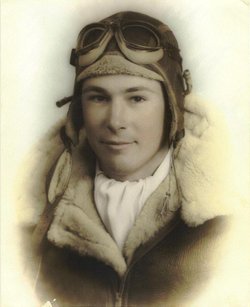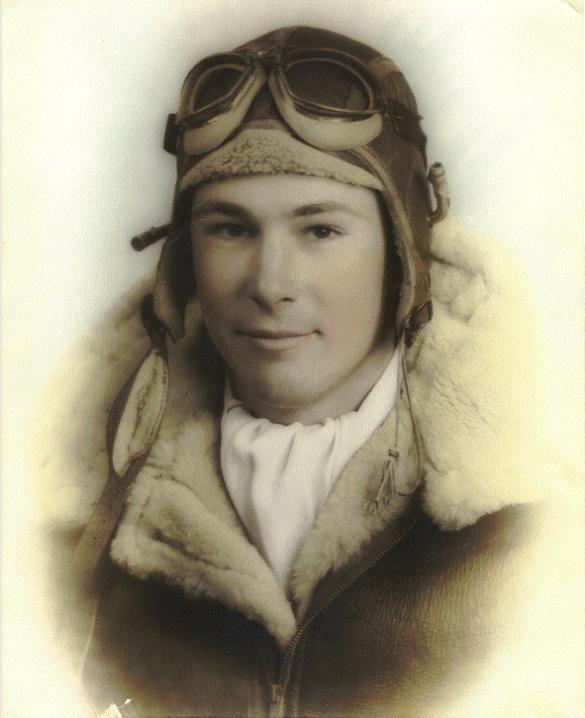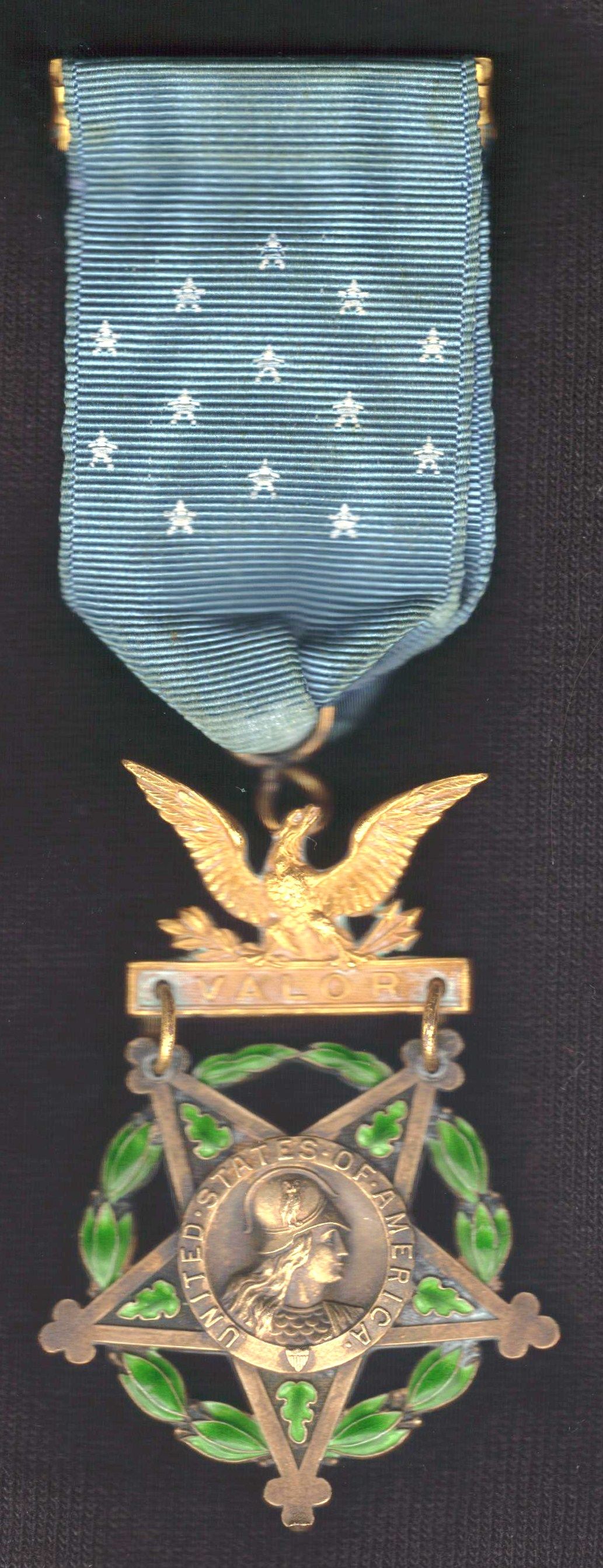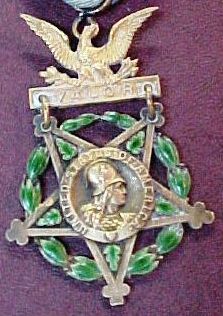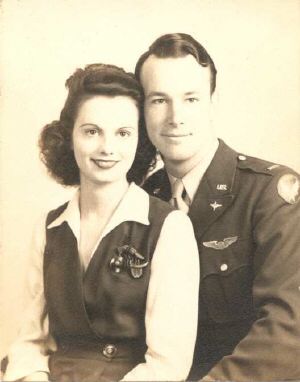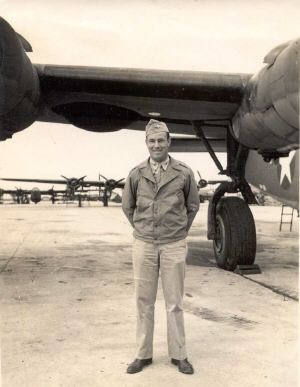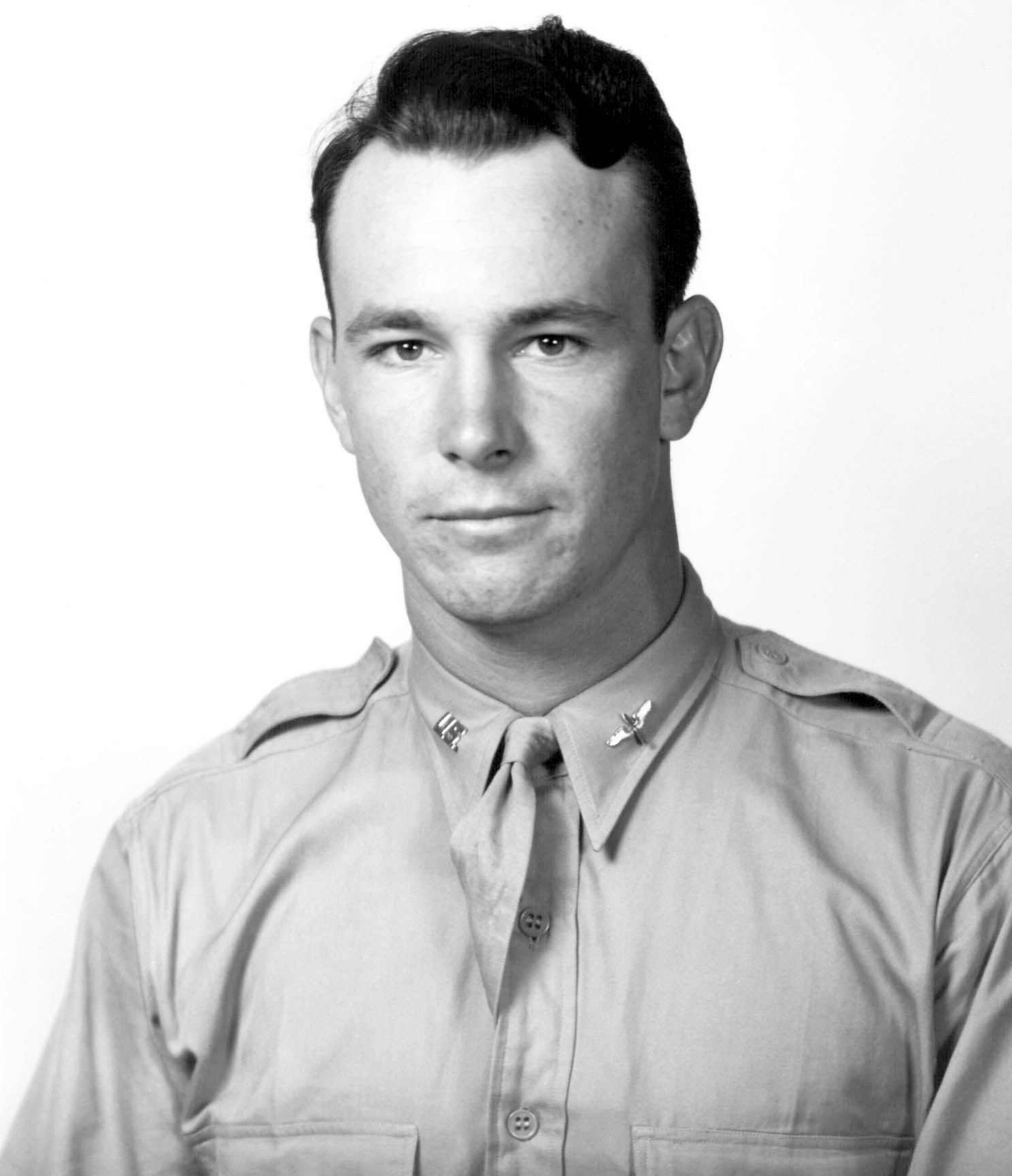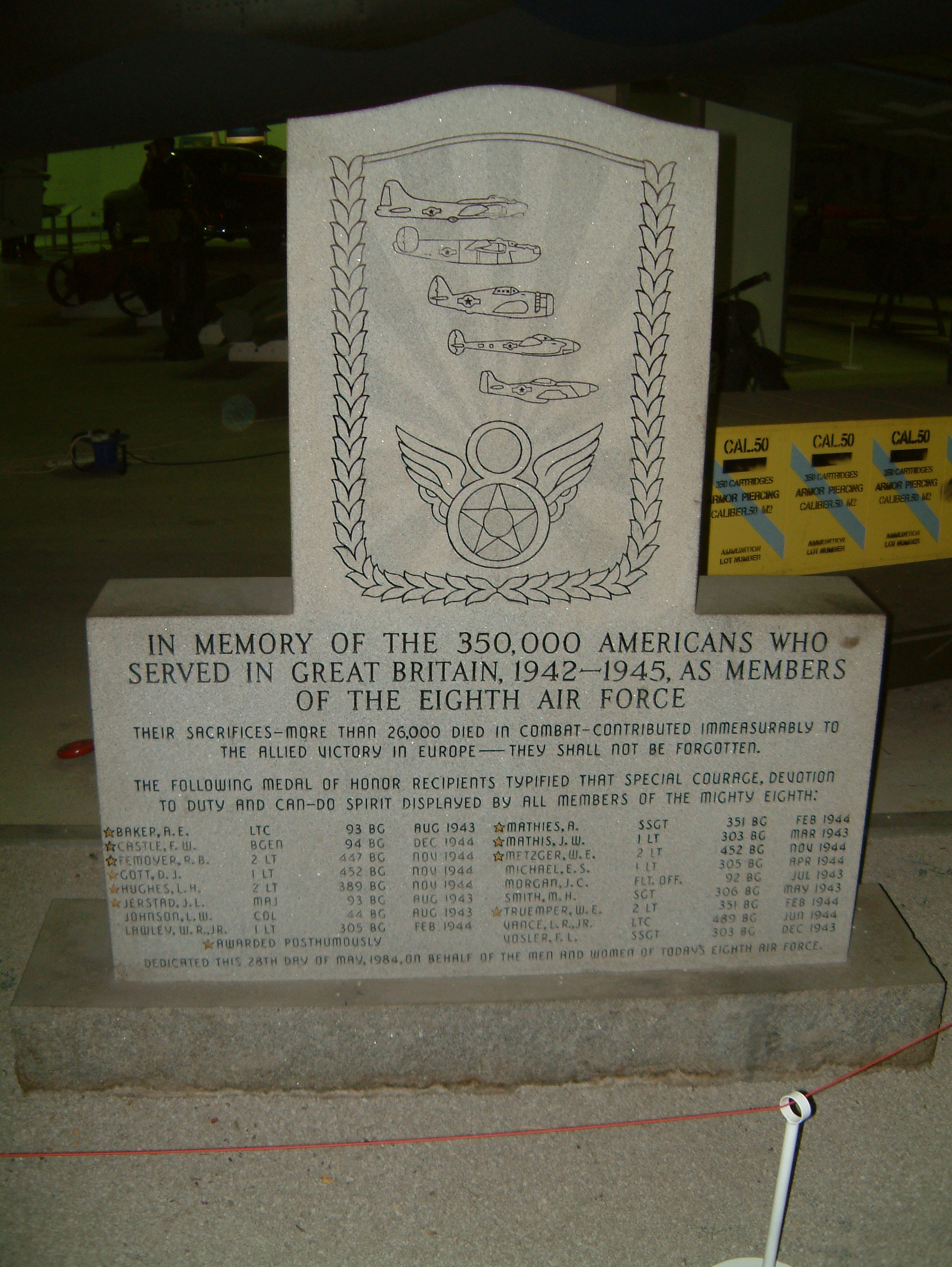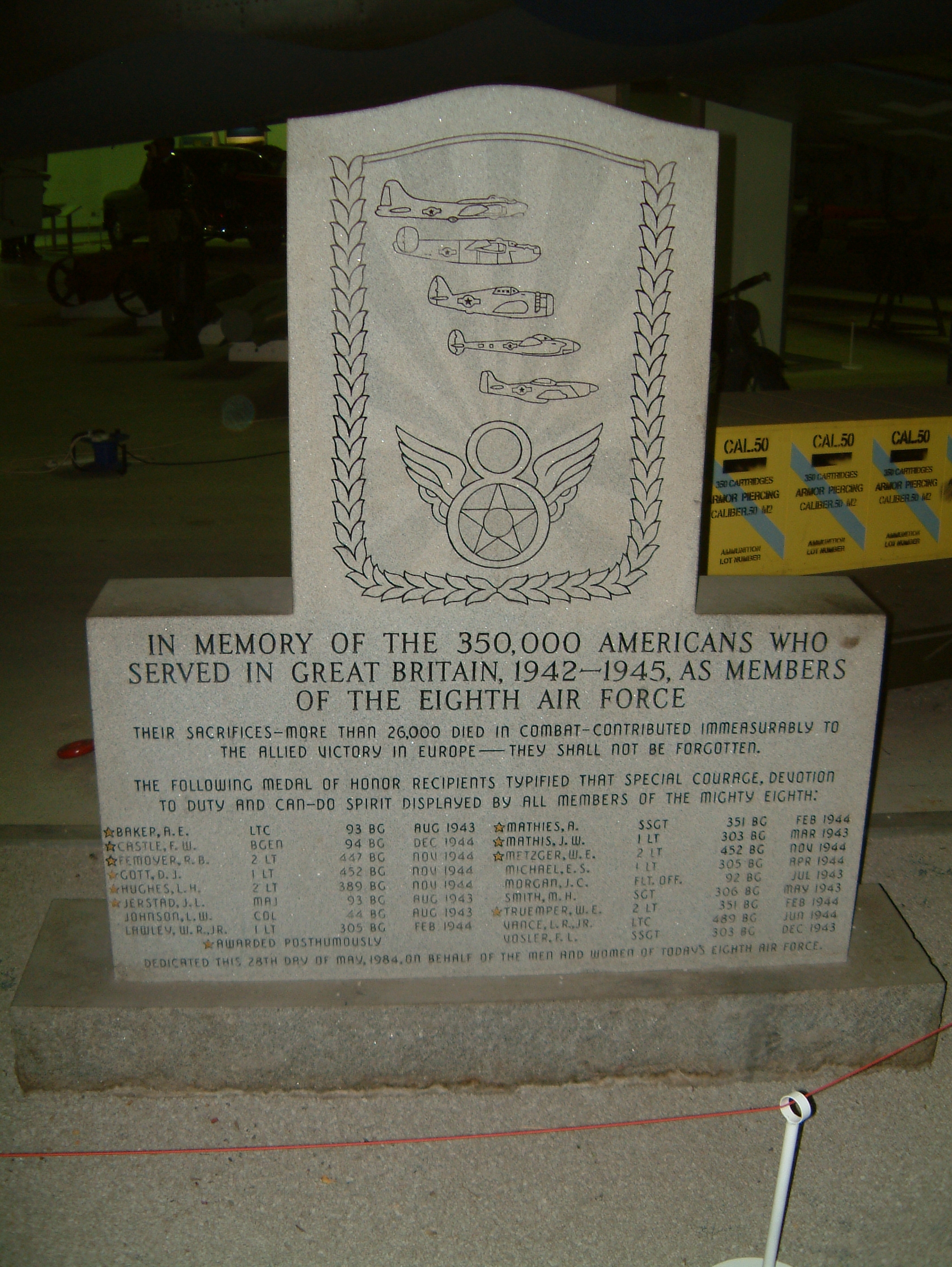Pete graduated from Refugio High School in the Spring of 1939, then became part of the Class of 1943 when he entered the Agricultural & Mechanical College of Texas (which became Texas A&M University in 1963) in College Station, Brazos County, Texas. Upon entering A&M, Pete was 6 foot 2 inches tall and weighed 184 pounds. He was interested in a career in the oil industry and was majoring in Petroleum Engineering. In February 1940, Pete had enrolled in Corpus Christi Junior College (which became Del Mar College in 1948) in Corpus Christi, Nueces County, Texas. By September 1941, Pete was back at A&M with five classes, but had to resign on 3 Dec 1941 for personal reasons. Four days later, the Japanese attacked Pearl Harbor.
Pete enlisted on 28 Jan 1942 into the Army Air Forces (AAF) as a Private in San Antonio, Bexar County, Texas. He was appointed an Aviation Cadet on the same day and entered Air Corps Replacement Training Center (Aircrew) at Kelly Field, San Antonio, Bexar County, Texas. He was just over 20 years and 6 months in age. His enlistment record shows that he was 6 foot 1 inches tall and weighed 181 pounds. He went to the AAF Primary Pilot Training School in Tulsa, County, Oklahoma, then on to AAF Basic Pilot Training School in Enid, Garfield County, Oklahoma. In Jul 1942, Pete received his AAF Advanced Pilot Training in Lubbock, Lubbock County, Texas and was transferred to Four Engine Transition School and Combat Crew School in Tarrant Air Base, Fort Worth, Tarrant County, Texas.
Pete married Hazel Dean Ewing on 8 Nov 1942 in San Antonio, Bexar County, Texas and on 10 Nov 1942, he was promoted to Second Lieutenant receiving his commission and his wings in Lubbock, Lubbock County, Texas. He was rated Pilot. Pete was immediately called to active duty with the Army Air Forces, 8th Air Force, 2nd Air Division, 389th Bombardment Group, 564th Bombardment Squadron. From 13 Nov 1942 to Jan 1943, Pete was stationed at Tarrant Field, Fort Worth, Tarrant County, Texas then on 18 Jan 1943, Pete graduated as a four-engine bomber pilot. From Jan 1943 to Feb 1943, Pete was stationed at Davis-Monthan Field, Tucson, Pima County, Arizona and from Feb 1943 to Mar 1943, Pete was stationed at Biggs Field, El Paso, El Paso County, Texas. From Apr 1943 to May 1943, Pete was stationed at Lowry Army Air Force Base, Denver, Colorado. On 13 Jun 1943, Pete and his crew flew from Lowry Army Air Force Base to Hethel Royal Air Force Base in England. On 1 Jul 1943, they flew from Hethel Royal Air Force Base to Benghazi, Cyrenaica region, Libya. The 389th was temporarily transferred from the 8th Air Forces to the 9th Air Forces to Benghazi in support of Operation Husky and Operation Tidal Wave.
On 9 Jul 1943, Pete and his crew flew their first bombing mission to Maleme Airdrome, Crete, Greece. On 11 Jul 1943, Pete and his crew flew their second bombing mission to Reggio Airdrome, Calabria province, Calabria region of Italy. On 16 Jul 1943, Pete and his crew flew their third bombing mission to Bari Airdrome, Bari province, Apulia region, Italy. On 19 Jul 1943, Pete and his crew flew their fourth bombing mission to Rome Littorio Rail Road Yards, Lazio region, Italy. On 1 Aug 1943, Pete and his crew flew their fifth and last bombing mission in "Operation Tidal Wave" also known as the Ploesti Raid. Their mission was an extremely low level bombing run over the Steaua Romana oil refinery in Campina, labeled "Red Target." Campina is about 18 miles north of Ploesti in the Prahova county, Wallachia region of Romania. They totally destroyed the the Steaua Romana refinery - it did not go into production again until some time in 1949.
Second Lieutenant Lloyd Herbert "Pete" Hughes' Medal of Honor Citation reads, "For conspicuous gallantry in action and intrepidity at the risk of his life above and beyond the call of duty. On 1 August 1943 Lieutenant Hughes served in the capacity of pilot of a heavy bombardment aircraft participating in a long and hazardous minimum altitude attack against the Axis oil refineries of Ploesti, Roumania, launched from the northern shores of Africa. Flying in the last formation to attack the target,he (sic - target, he) arrived in the target area after previous flights had thoroughly alerted the enemy defenses. Approaching the target through intense and accurate anti-aircraft fire and dense balloon barrages at dangerously low altitude, his airplane received several direct hits from both large and small caliber antiaircraft guns which seriously damaged his aircraft causing sheets of escaping gasoline to stream from the bomb bay and from the left wing. This damage was inflicted at a time prior to reaching the target when Lieutenant Hughes could have made a forced landing in any of the grain fields readily available at that time. The target area was blazing with burning oil tanks and damaged refinery installation from which flames leaped above the bombing level of the formation. With full knowledge of the consequences of entering this blazing inferno when his airplane was profusely leaking gasoline in two separate locations, Lieutenant Hughes, motivated only by his high conception of duty which called for the destruction of his assigned target at any cost, did not elect to make a forced landing or turn back from the attack. Instead, rather than jeopardize the formation and the success of the attack, he unhesitatingly entered the blazing area and dropped his bomb load with great precision. After successfully bombing the objective, his aircraft emerged from the conflagration with the left wing aflame. Only then did he attempt a forced landing, but because of the advanced state of the fire enveloping his aircraft, the airplane crashed and was consumed. By Lieutenant Hughes' heroic decision to complete his mission regardless of the consequences, in utter disregard for his own life, and by his gallant and valorous execution of this decision, he rendered a service to our country in the defeat of our enemies which will everlastingly be outstanding in the annals of our nation's history."
Second Lieutenant Lloyd Herbert "Pete" Hughes (Serial Number: O-666292), of the U.S. Army Air Forces, 9th Air Force, 2nd Air Division, 389th Bombardment Group (Heavy), 564th Bombardment Squadron, died while trying to land his B-24 in the dry river bed of the Prahova River, Campina, Romania. He was the Pilot of a B-24 D heavy bomber, the Liberator, aircraft #42-40753 J, nicknamed "Ole Kickapoo." Ironically, as a college student he had majored in petroleum engineering, then he died trying to destroy an oil refinery. He was just 22 years, 20 days old.
Other decorations and awards: Purple Heart (Posthumous), American Campaign Medal, European-African-Middle Eastern Campaign Medal with three Bronze Service Stars for participation in the Air Offensive Europe, Sicily, and Air Combat Campaigns, World War II Victory Medal, Distinguished Unit Citation Emblem, Meritorious Unit Commendation Emblem, Aviation Badge "Pilot"
Survivors included his wife, Hazel Dean Ewing Hughes; his mother and step-father, Mildred Mae Rainey Hughes Jordan and John Raymond Jordan, Sr.; four half brothers, James, John, William and Paul; and his grandparents, Stephen Marion Rainey and Emily Elizabeth Josserand Rainey.
His Famous Find A Grave Memorial.
Visit the virtual cemetery of the "Ole Kickapoo" Crew.
The five US Army Air Forces men who received Medals of Honor for their actions on 1 Aug 1943:
Lloyd Herbert "Pete" Hughes
Addison Earl Baker
John Louis Jerstad
Leon William Johnson
John Riley Kane
The seven Texas A&M Aggies who received the Medal of Honor in World War II:
Lloyd Herbert "Pete" Hughes
Horace Seaver Carswell
Thomas Weldon Fowler
William George Harrell
George Dennis Keathley
Turney White Leonard
Eli Lamar Whiteley
Note to Find A Grave and Ancestry: This is a memorial permitted by Jim Tipton and sponsored by a family member. Please do not merge it with the famous memorial.
Pete graduated from Refugio High School in the Spring of 1939, then became part of the Class of 1943 when he entered the Agricultural & Mechanical College of Texas (which became Texas A&M University in 1963) in College Station, Brazos County, Texas. Upon entering A&M, Pete was 6 foot 2 inches tall and weighed 184 pounds. He was interested in a career in the oil industry and was majoring in Petroleum Engineering. In February 1940, Pete had enrolled in Corpus Christi Junior College (which became Del Mar College in 1948) in Corpus Christi, Nueces County, Texas. By September 1941, Pete was back at A&M with five classes, but had to resign on 3 Dec 1941 for personal reasons. Four days later, the Japanese attacked Pearl Harbor.
Pete enlisted on 28 Jan 1942 into the Army Air Forces (AAF) as a Private in San Antonio, Bexar County, Texas. He was appointed an Aviation Cadet on the same day and entered Air Corps Replacement Training Center (Aircrew) at Kelly Field, San Antonio, Bexar County, Texas. He was just over 20 years and 6 months in age. His enlistment record shows that he was 6 foot 1 inches tall and weighed 181 pounds. He went to the AAF Primary Pilot Training School in Tulsa, County, Oklahoma, then on to AAF Basic Pilot Training School in Enid, Garfield County, Oklahoma. In Jul 1942, Pete received his AAF Advanced Pilot Training in Lubbock, Lubbock County, Texas and was transferred to Four Engine Transition School and Combat Crew School in Tarrant Air Base, Fort Worth, Tarrant County, Texas.
Pete married Hazel Dean Ewing on 8 Nov 1942 in San Antonio, Bexar County, Texas and on 10 Nov 1942, he was promoted to Second Lieutenant receiving his commission and his wings in Lubbock, Lubbock County, Texas. He was rated Pilot. Pete was immediately called to active duty with the Army Air Forces, 8th Air Force, 2nd Air Division, 389th Bombardment Group, 564th Bombardment Squadron. From 13 Nov 1942 to Jan 1943, Pete was stationed at Tarrant Field, Fort Worth, Tarrant County, Texas then on 18 Jan 1943, Pete graduated as a four-engine bomber pilot. From Jan 1943 to Feb 1943, Pete was stationed at Davis-Monthan Field, Tucson, Pima County, Arizona and from Feb 1943 to Mar 1943, Pete was stationed at Biggs Field, El Paso, El Paso County, Texas. From Apr 1943 to May 1943, Pete was stationed at Lowry Army Air Force Base, Denver, Colorado. On 13 Jun 1943, Pete and his crew flew from Lowry Army Air Force Base to Hethel Royal Air Force Base in England. On 1 Jul 1943, they flew from Hethel Royal Air Force Base to Benghazi, Cyrenaica region, Libya. The 389th was temporarily transferred from the 8th Air Forces to the 9th Air Forces to Benghazi in support of Operation Husky and Operation Tidal Wave.
On 9 Jul 1943, Pete and his crew flew their first bombing mission to Maleme Airdrome, Crete, Greece. On 11 Jul 1943, Pete and his crew flew their second bombing mission to Reggio Airdrome, Calabria province, Calabria region of Italy. On 16 Jul 1943, Pete and his crew flew their third bombing mission to Bari Airdrome, Bari province, Apulia region, Italy. On 19 Jul 1943, Pete and his crew flew their fourth bombing mission to Rome Littorio Rail Road Yards, Lazio region, Italy. On 1 Aug 1943, Pete and his crew flew their fifth and last bombing mission in "Operation Tidal Wave" also known as the Ploesti Raid. Their mission was an extremely low level bombing run over the Steaua Romana oil refinery in Campina, labeled "Red Target." Campina is about 18 miles north of Ploesti in the Prahova county, Wallachia region of Romania. They totally destroyed the the Steaua Romana refinery - it did not go into production again until some time in 1949.
Second Lieutenant Lloyd Herbert "Pete" Hughes' Medal of Honor Citation reads, "For conspicuous gallantry in action and intrepidity at the risk of his life above and beyond the call of duty. On 1 August 1943 Lieutenant Hughes served in the capacity of pilot of a heavy bombardment aircraft participating in a long and hazardous minimum altitude attack against the Axis oil refineries of Ploesti, Roumania, launched from the northern shores of Africa. Flying in the last formation to attack the target,he (sic - target, he) arrived in the target area after previous flights had thoroughly alerted the enemy defenses. Approaching the target through intense and accurate anti-aircraft fire and dense balloon barrages at dangerously low altitude, his airplane received several direct hits from both large and small caliber antiaircraft guns which seriously damaged his aircraft causing sheets of escaping gasoline to stream from the bomb bay and from the left wing. This damage was inflicted at a time prior to reaching the target when Lieutenant Hughes could have made a forced landing in any of the grain fields readily available at that time. The target area was blazing with burning oil tanks and damaged refinery installation from which flames leaped above the bombing level of the formation. With full knowledge of the consequences of entering this blazing inferno when his airplane was profusely leaking gasoline in two separate locations, Lieutenant Hughes, motivated only by his high conception of duty which called for the destruction of his assigned target at any cost, did not elect to make a forced landing or turn back from the attack. Instead, rather than jeopardize the formation and the success of the attack, he unhesitatingly entered the blazing area and dropped his bomb load with great precision. After successfully bombing the objective, his aircraft emerged from the conflagration with the left wing aflame. Only then did he attempt a forced landing, but because of the advanced state of the fire enveloping his aircraft, the airplane crashed and was consumed. By Lieutenant Hughes' heroic decision to complete his mission regardless of the consequences, in utter disregard for his own life, and by his gallant and valorous execution of this decision, he rendered a service to our country in the defeat of our enemies which will everlastingly be outstanding in the annals of our nation's history."
Second Lieutenant Lloyd Herbert "Pete" Hughes (Serial Number: O-666292), of the U.S. Army Air Forces, 9th Air Force, 2nd Air Division, 389th Bombardment Group (Heavy), 564th Bombardment Squadron, died while trying to land his B-24 in the dry river bed of the Prahova River, Campina, Romania. He was the Pilot of a B-24 D heavy bomber, the Liberator, aircraft #42-40753 J, nicknamed "Ole Kickapoo." Ironically, as a college student he had majored in petroleum engineering, then he died trying to destroy an oil refinery. He was just 22 years, 20 days old.
Other decorations and awards: Purple Heart (Posthumous), American Campaign Medal, European-African-Middle Eastern Campaign Medal with three Bronze Service Stars for participation in the Air Offensive Europe, Sicily, and Air Combat Campaigns, World War II Victory Medal, Distinguished Unit Citation Emblem, Meritorious Unit Commendation Emblem, Aviation Badge "Pilot"
Survivors included his wife, Hazel Dean Ewing Hughes; his mother and step-father, Mildred Mae Rainey Hughes Jordan and John Raymond Jordan, Sr.; four half brothers, James, John, William and Paul; and his grandparents, Stephen Marion Rainey and Emily Elizabeth Josserand Rainey.
His Famous Find A Grave Memorial.
Visit the virtual cemetery of the "Ole Kickapoo" Crew.
The five US Army Air Forces men who received Medals of Honor for their actions on 1 Aug 1943:
Lloyd Herbert "Pete" Hughes
Addison Earl Baker
John Louis Jerstad
Leon William Johnson
John Riley Kane
The seven Texas A&M Aggies who received the Medal of Honor in World War II:
Lloyd Herbert "Pete" Hughes
Horace Seaver Carswell
Thomas Weldon Fowler
William George Harrell
George Dennis Keathley
Turney White Leonard
Eli Lamar Whiteley
Note to Find A Grave and Ancestry: This is a memorial permitted by Jim Tipton and sponsored by a family member. Please do not merge it with the famous memorial.
Inscription
†
LLOYD H
HUGHES
MEDAL OF HONOR
2D LT
ARMY AIR FORCES
WORLD WAR II
JUL 12 1921
AUG 1 1943
